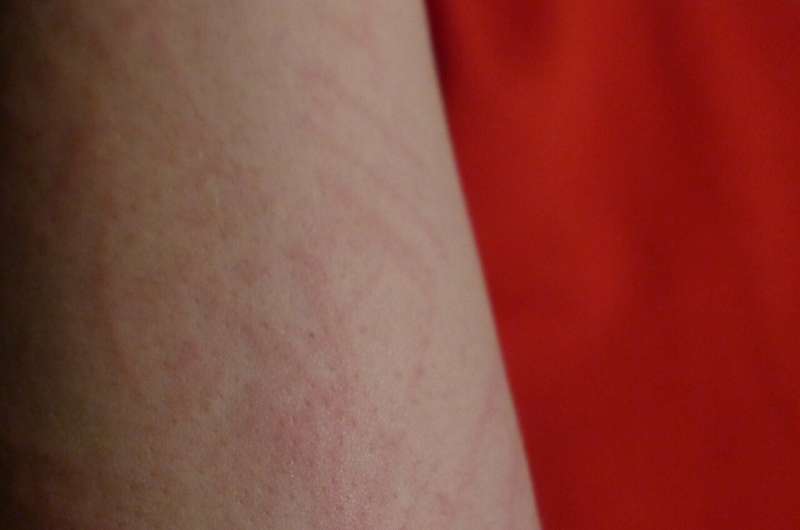This article has been reviewed according to Science X's editorial process and policies. Editors have highlighted the following attributes while ensuring the content's credibility:
fact-checked
trusted source
written by researcher(s)
proofread
Your skin is a mirror of your health: What yours might be saying

Skin accounts for around 15% of our body mass. It is the largest and most visible organ in the human body.
Yet many of the skin's functions are often overlooked. It's a sunscreen, a shield from germs, a reservoir of vitamin D and a means of tightly regulating our body temperature.
Being the most visible of our organs, the skin also offers us a view into the body tissues that it protects. So don't think of your skin merely aesthetically—think of it as a reflection of your health. Disorders of the gut, blood, hormones and even the heart might first be seen on the skin in the form of a rash.
Here are a few to look out for.
Bullseye
Ticks are pesky creatures that no one will want to return home from a country walk with.
But while the vast majority of tick bites won't make you ill, there is one rash that should prompt a visit to your doctor if you spot it.
Erythema migrans, a rash named for its ability to rapidly expand across the skin, is a hallmark of Lyme disease, a potentially severe bacterial illness. This rash forms a classic target pattern, like a bullseye on a dartboard.
Be vigilant for a few weeks after being bitten to check this rash doesn't make an appearance—especially if you noticed a red lump that wasn't there before or if you had to remove a tick from your skin. You should also keep an eye out for other associated symptoms of Lyme disease—such as swinging temperatures, muscle and joint pains and headache.
The condition is treated with antibiotics, which can prevent long-term complications, including chronic fatigue symptoms.
Purpura
Some rashes are given a colorful namesake—purpura is one such example. This rash's name is derived from a mollusk which was used to make purple dye.
Purpura refers to a rash of small purple or red dots. The cause is pooling of blood into a deeper layer of the skin (dermis). When pressed with a finger—or even better, the side of a glass—it refuses to blanch away.
Purpura signals an issue with either the walls of the tiny blood vessels that feed the skin or the blood within them. This might be from a deficiency in platelets, the tiny cell fragments that allow blood to clot—perhaps from bone marrow failure, or an autoimmune condition where the body turns on itself and attacks its own cells.
At worst, purpura may signal the life-threatening condition septicaemia, where an infection has spread into the bloodstream—perhaps from the lungs, kidneys or even from the skin itself.
Skin spiders
Skin rashes can also take on recognizable shapes.
Spider naevi represent an issue within skin arterioles (small arteries which supply the skin with blood). Arterioles open and close to control the loss of heat from the body's surface. But sometimes they can get stuck open—and a spider-like pattern will appear.
The open arteriole is the spider's body, and the even tinier capillaries fanning out in all directions are the thready legs. Crush the body under a fingertip and the whole thing disappears, as your touch temporarily stops the blood flow.
Often, these are benign and not associated with any specific condition—especially if you only have one or two. However, more than three suggest higher circulating levels of the hormone estrogen, often due to liver disease or from the hormonal changes seen in pregnancy. Treat the underlying cause, and the spiders often vanish with time—though they may persist or reappear later.
Black velvet
Changes to the folds of your skin (usually around the armpits or neck)—especially if it becomes thickened and velveteen to the touch—may suggest a condition known as acanthosis nigricans. This "black velvet" skin appearance is more commonly seen in darker skins.
Usually, the condition is associated with disorders of the metabolism—namely type 2 diabetes and polycystic ovary syndrome. If either of these conditions are successfully treated, the rash may fade. In rare cases, it can also be a sign of stomach cancer, which should be considered in patients with few or none of the key signs of metabolic disease (obesity and high blood pressure).
Butterfly rashes
Even disorders of the heart can be visible on the skin.
Cardiac valves have the important role of correctly directing the journey of blood through the heart and preventing backflow. The valve between the chambers on the left side of the heart (the mitral valve—so called because of its resemblance to a bishop's hat, or miter) can sometimes become narrowed, causing the heart's function to deteriorate. The body's natural response is to preserve core blood volume, shutting off flow towards the skin.
The net effect can produce a purple-red rash, high across the cheeks and the bridge of the nose, like the outstretched wings of a butterfly. We call this mitral facies which, depending on the extent of damage to the heart and great vessels, may persist despite treatment.
It's important to pay heed to your skin. It's constantly talking to you, and any changes in its texture, color or if new marks or patterns appear, may indicate something is going on beneath the surface.
This article is republished from The Conversation under a Creative Commons license. Read the original article.![]()




















